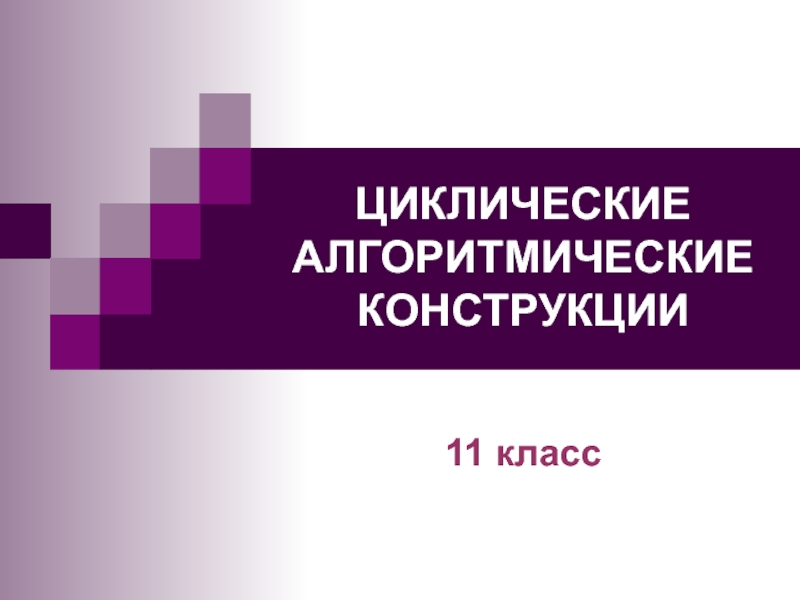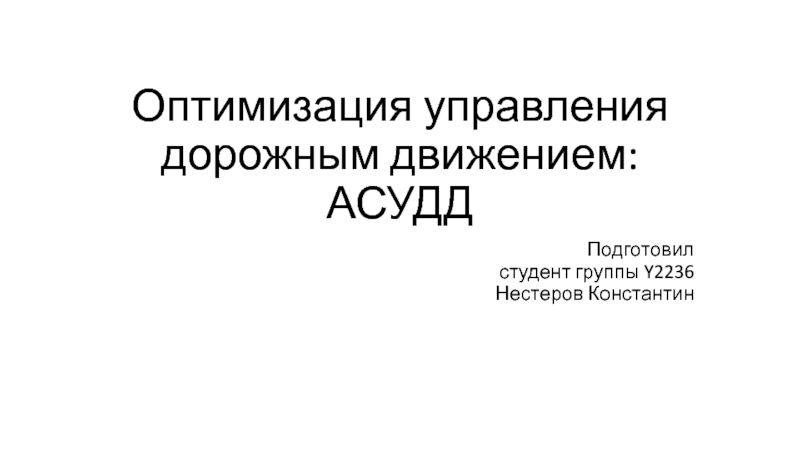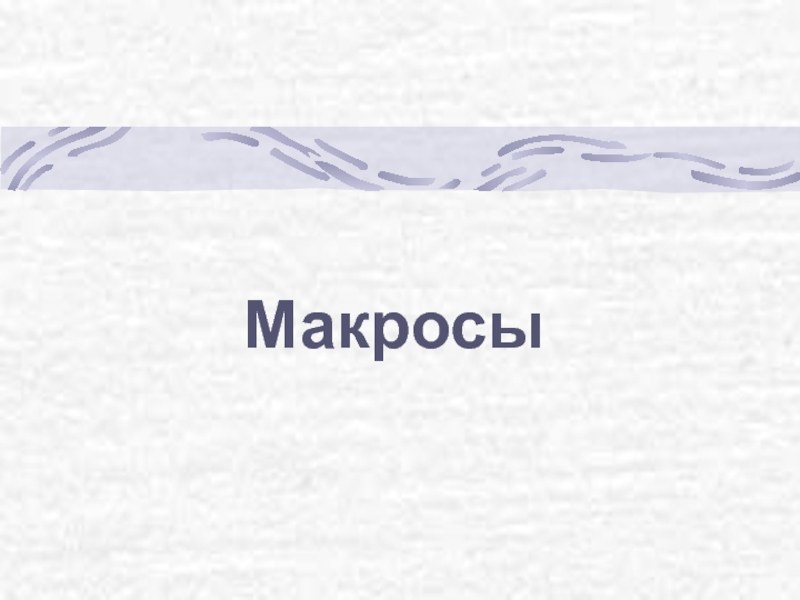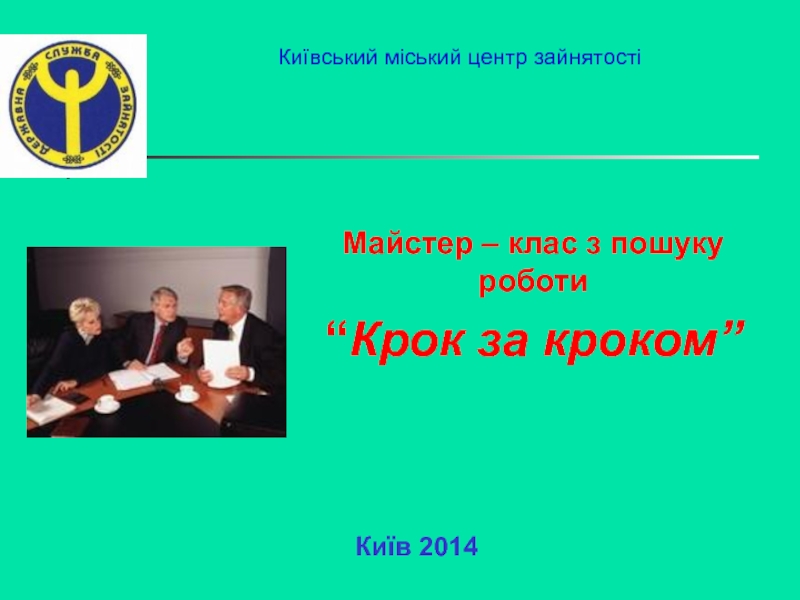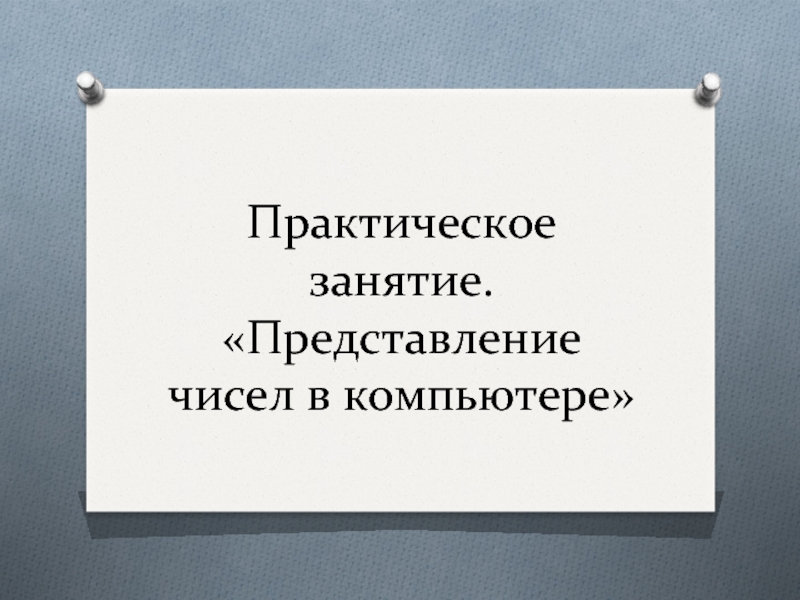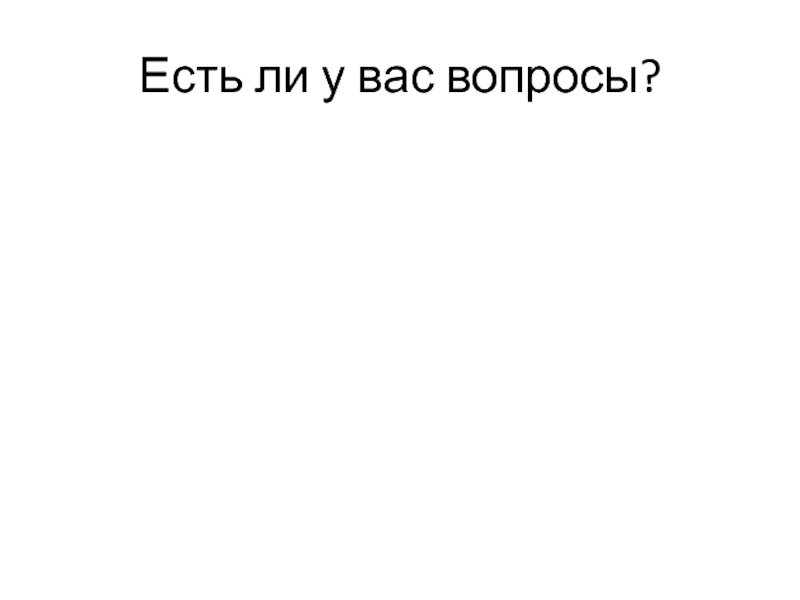- Главная
- Разное
- Дизайн
- Бизнес и предпринимательство
- Аналитика
- Образование
- Развлечения
- Красота и здоровье
- Финансы
- Государство
- Путешествия
- Спорт
- Недвижимость
- Армия
- Графика
- Культурология
- Еда и кулинария
- Лингвистика
- Английский язык
- Астрономия
- Алгебра
- Биология
- География
- Детские презентации
- Информатика
- История
- Литература
- Маркетинг
- Математика
- Медицина
- Менеджмент
- Музыка
- МХК
- Немецкий язык
- ОБЖ
- Обществознание
- Окружающий мир
- Педагогика
- Русский язык
- Технология
- Физика
- Философия
- Химия
- Шаблоны, картинки для презентаций
- Экология
- Экономика
- Юриспруденция
Real-time Diffuse Global Illumination in CryENGINE 3 презентация
Содержание
- 2. Real-time Diffuse Global Illumination in CryENGINE 3 Anton Kaplanyan antonk@crytek.de
- 3. Crytek GmbH 10 years in game development
- 4. Global Illumination in games Mirror’s Edge Halo 3 RAGE Danger Planet
- 5. Why dynamic Global Illumination? Most games use
- 6. Diffuse Global Illumination in Crysis 2™
- 7. Diffuse Global Illumination in Crysis 2™
- 8. CASCADED LIGHT PROPAGATION VOLUMES
- 9. Core Idea Sample lit surfaces Treat them
- 10. Sampling the scene for GI We use
- 11. Sampling the scene for GI
- 12. Clustering Surfels Lit surfels represented as Virtual
- 13. Clustering Surfels
- 14. Propagation ACM SIGGRAPH Symposium on Interactive 3D
- 15. Propagation, cont’d Local cell-to-cell propagation across the
- 16. Final scene rendering with LPV Look-up resulting
- 17. Results
- 18. Results
- 19. Results
- 20. Results
- 21. Propagation example
- 22. Stabilizing solution Spatial stabilization Snap RSM by
- 23. Limitations of the method Only diffuse inter-reflections
- 24. Multi-resolution approach Render several nested RSMs at
- 25. Cascaded Light Propagation Volumes
- 26. Extensions Transparent objects Lighting caching for massive
- 27. Global Illumination on particles
- 28. Why does it work so good? Human
- 29. How far are we from ground truth?
- 30. Comparison
- 31. Tools for game production GI editing tools
- 32. Tools for game production GI tools for
- 33. Combination with other techniques Multiply with SSAO
- 34. Global Illumination simulated with Deferred Lights
- 35. Console optimizations For both consoles Store everything
- 36. Console optimizations , cont’d Render Reflective Shadow
- 37. Performance ACM SIGGRAPH Symposium on Interactive 3D
- 38. Performance, cont’d ACM SIGGRAPH Symposium on Interactive
- 39. Conclusion Full-dynamic approach, changing scene/view/lighting GPU- and
- 40. Q&A Find the last version of course notes at: http://www.crytek.com/technology/presentations/ Anton Kaplanyan antonk@crytek.de
- 41. References [Bunnel05] Bunnel, M. 2005 “Dynamic ambient
Слайд 3Crytek GmbH
10 years in game development
~650 employees in 5 offices across
Multicultural company with 30+ languages
Shipped:
FarCry on CryENGINE 1 in 2001 (PC only)
Crysis and Crysis Warhead on CryENGINE 2 in 2007-8 (PC only)
Multi-platform consoles-ready CryENGINE 3
Currently working hard on Crysis 2…
Q4 2010
Слайд 5Why dynamic Global Illumination?
Most games use precomputed indirect lighting (Lightmaps, PRT
Means static scene/lighting
CryENGINE 3® includes following features:
Dynamic deferred lighting
Objects’ breakability as a part of game-play
That cancels out all precomputed GI methods
We’ve tried out most of it (including Lightmaps, PRT, RAM etc)
But we came up with a solution….
Слайд 9Core Idea
Sample lit surfaces
Treat them as secondary light sources
Cluster samples into
Sum up and average radiance in each cell
Iteratively propagate radiance to adjacent cells, works only for diffuse
Lit the scene with the resulting grid
Слайд 10Sampling the scene for GI
We use surfels (aka “points”, “disks”)
Surfel ==
All lit surfels can be flattened into 2D map in light’s space
Reflective Shadow Maps [DS05]
Fastest way to sample lit surfels on GPU
Even excessively
Depth
Слайд 12Clustering Surfels
Lit surfels represented as Virtual Point Lights
Comes from Instant Radiosity
Distribute each surfel into the closest grid cell
Similar to PBGI, light-cuts and radiosity clustering
Convert all VPLs into outgoing radiance distribution
Represent in Spherical Harmonics with lower bands
Sum it up in the center of owner grid cell
Done completely on GPU using rasterization
Слайд 14Propagation
ACM SIGGRAPH Symposium on Interactive 3D Graphics and Games 2010, Washington
Reflective
Radiance volume gathering
VPL
VPL
VPL
Discretize initial VPL distribution by the regular grid and SH
A set of regularly sampled VPLs of the scene from light position
Слайд 15Propagation, cont’d
Local cell-to-cell propagation
across the 3D grid
Similar to SH Discrete Ordinate
6 axial directions with contour faces as a propagation wave front
Accumulate the resulting SH coefficients into the destination cell for next iteration
Слайд 16Final scene rendering with LPV
Look-up resulting grid 3D texture at certain
Convolve the irradiance with cosine lobe of surface’s normal being illuminated
Apply dampening factor to avoid self-bleeding
Compute directional derivative towards normal
Dampen based on gradient deviation from the intensity distribution direction
Слайд 22Stabilizing solution
Spatial stabilization
Snap RSM by one pixel for conservative rasterization
Snap LPV
Self-illumination
Half-cell VPL shifting to normal direction during RSM injection
Temporal coherence and reprojection
Temporal SSAA with reprojection for RSM injection
Слайд 23Limitations of the method
Only diffuse inter-reflections
Sparse spatial and
low-frequency angular
approximations
Light
Spatial discretization: visible for occlusion and very coarse grids
Incomplete information for secondary occlusion
Слайд 24Multi-resolution approach
Render several nested RSMs at different resolutions
Inspired by cascaded shadow
Simulates uneven multi-resolution rendering on GPU
Distribute objects into different RSMs based on their size
Inject RSMs into corresponding LPVs
Create nested LPV grids that bound RSM frustums
Do propagation and rendering independently
Propagate from inner LPV to outer one
Слайд 26Extensions
Transparent objects
Lighting caching for massive lighting approximation
Inject analytical radiance into grid
Secondary occlusion with additional occlusion grid
Multiple bounces possible using the same trick
Glossy reflections by partial matching in LPV
Participating media illumination
Comes inherently from the propagation process’ nature
Слайд 28Why does it work so good?
Human perception of Indirect Lighting
Very sensitive
Indirect lighting is mostly in low frequency
Even for indirect shadows
Smooth gradients instead of flat ambient in shadow
Approximated as diffusion process in participating media
Cascades: importance-based clustering
Emitters are distributed across cascades based on its size
Слайд 29How far are we from ground truth?
ACM SIGGRAPH Symposium on Interactive
Слайд 31Tools for game production
GI editing tools for artists:
GI intensity for each
Mark objects as non-casters and/or non-receivers
Слайд 32Tools for game production
GI tools for artists:
Per material indirect
color and
Optionally apply on any transparent objects and particles
Clip areas: provides control over indoors
Transition areas: provides smooth GI changes across level areas / game events
Слайд 33Combination with other techniques
Multiply with SSAO to add micro-occlusion details
Deferred environment
Combined to augment for distant GI
Fill lights and deferred lights
Simulating GI with fill lights at some places
Important for artists for GI stylization
Слайд 35Console optimizations
For both consoles
Store everything in signed QUVW8 format, [-1;1] with
Use h/w 3D textures and trilinear filtering
Xbox 360
Unwrap RT vertically to avoid bank conflicts during injection (next slide)
Use API bug work-around to resolve into a 3D slice
PlayStation 3
Use memory aliasing for render into 3D texture
Use 2x MSAA aliasing to reduce pixel work twice
ACM SIGGRAPH Symposium on Interactive 3D Graphics and Games 2010, Washington
Слайд 36Console optimizations , cont’d
Render Reflective Shadow Map
Usually 128 x 128 is
Inject each pixel into unwrapped LPV with a swarm of points
16384 points in one DIP
Use vertex texture fetch on X360
Use R2VB on PlayStation 3
Multi-layered unwrapping to avoid bank conflicts during RSM injection
Combine LPV rendering pass with SSAO to amortize the cost
Слайд 37Performance
ACM SIGGRAPH Symposium on Interactive 3D Graphics and Games 2010, Washington
Depends
Depends on image size (1280x720)
8 iterations
32^3 grid size
Refresh once per 5 frames
Reprojection for camera movement
Слайд 38Performance, cont’d
ACM SIGGRAPH Symposium on Interactive 3D Graphics and Games 2010,
Once per 5 frames
Once per frame
Слайд 39Conclusion
Full-dynamic approach, changing scene/view/lighting
GPU- and consoles- friendly
Extremely fast (takes ~1 ms/frame
Production-eligible (rich toolset for real-time tweaking)
Highly scalable, proportionally to quality
Stable, flicker-free
Supports complex geometry (e.g. foliage)
Слайд 40Q&A
Find the last version of course notes at: http://www.crytek.com/technology/presentations/
Anton Kaplanyan
antonk@crytek.de
Слайд 41References
[Bunnel05] Bunnel, M. 2005 “Dynamic ambient occlusion and indirect lighting”, GPU
[Christensen07] Christensen, P. 2007. “Point-based approximated color bleeding,” Tech Memo, Pixar.
[DS05] Dachsbacher, C., and Stamminger, M. 2005. Reflective shadow maps. In Proc. of the Symposium on Interactive 3D Graphics and Games
[GRWS04] Geist, R., Rasche, K., Westall, J., and Schalkoff, R. J. 2004. Lattice-boltzmann lighting. In Rendering Techniques 2004 (Proc. of the Eurographics Symposium on Rendering
[KD10] Kaplanyan A., Dachsbacher C. 2010. Cascaded Light Propagation Volumes, In Proc. of the ACM SIGGraph Symposium on Interactive 3D Graphics and Games
[KELLER97] Keller, A. 1997. Instant radiosity. In SIGGRAPH ’97: Proceedings of the 24th annual conference on Computer graphics and interactive techniques
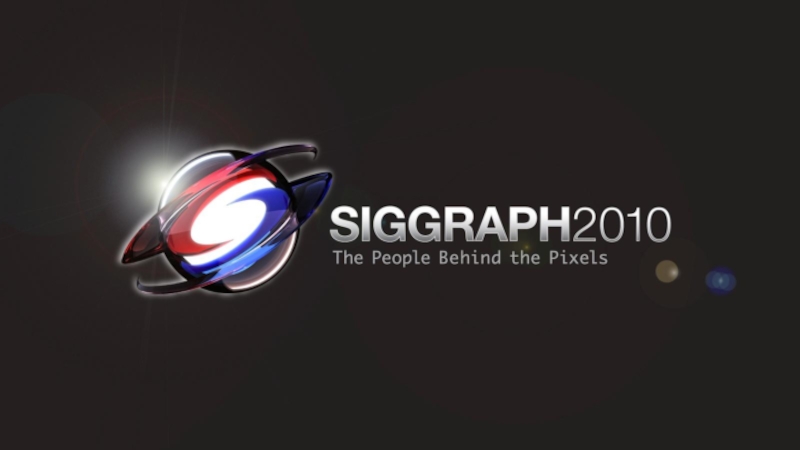

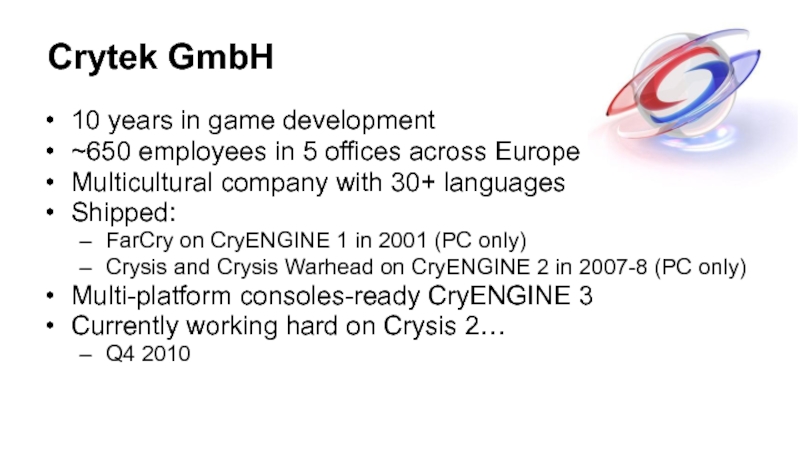
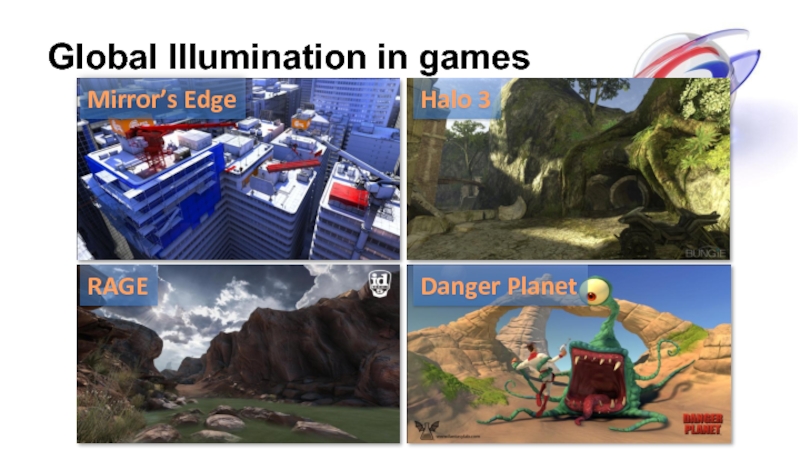




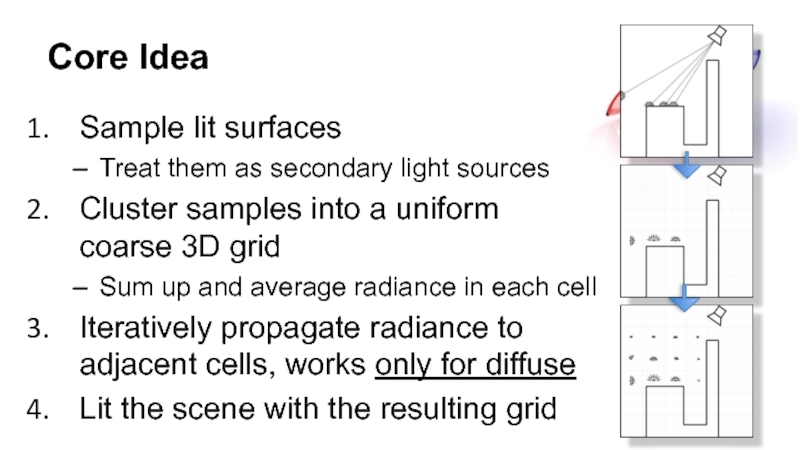
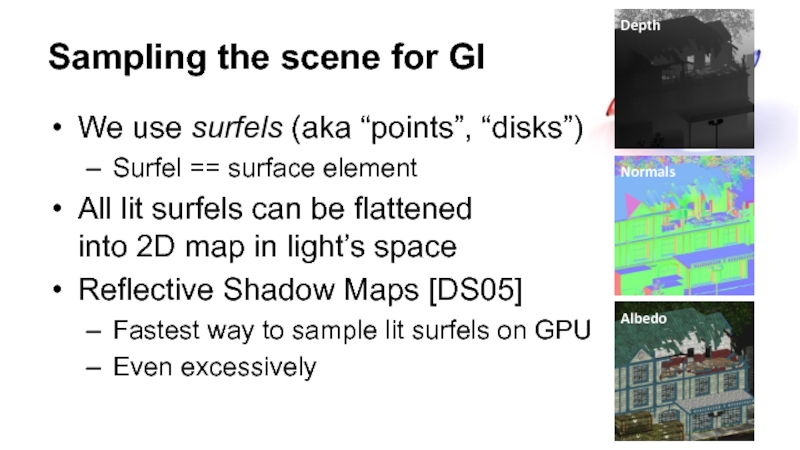

![Clustering SurfelsLit surfels represented as Virtual Point LightsComes from Instant Radiosity approach [Keller97]Distribute each surfel](/img/tmb/1/29259/da49e3908202521fa50290be825d90a8-800x.jpg)
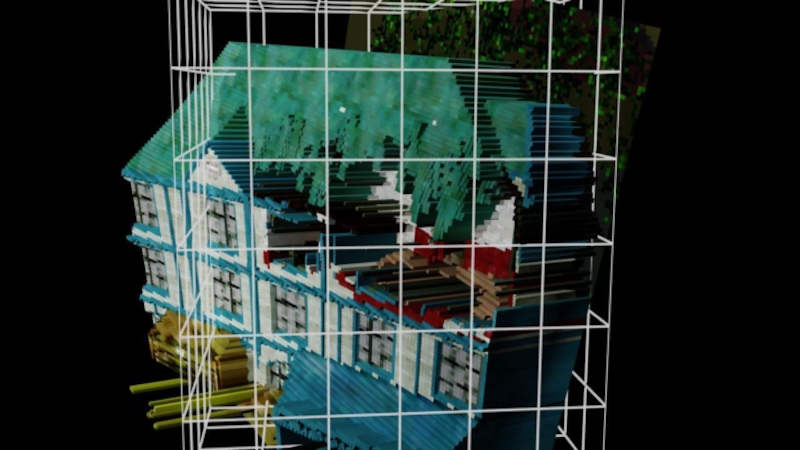






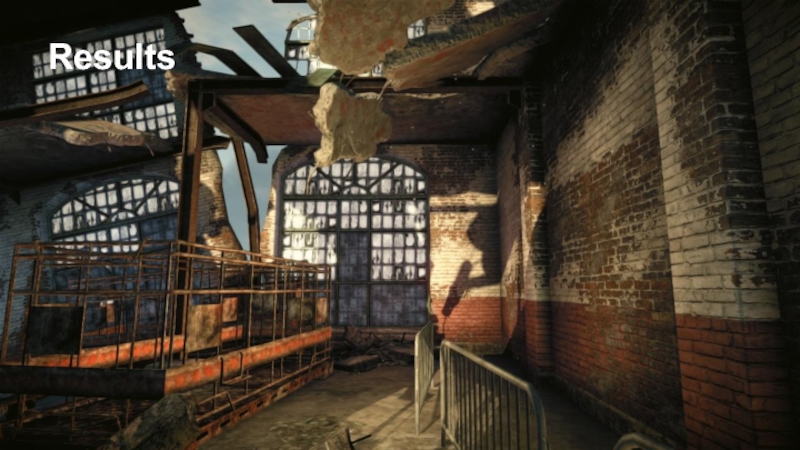
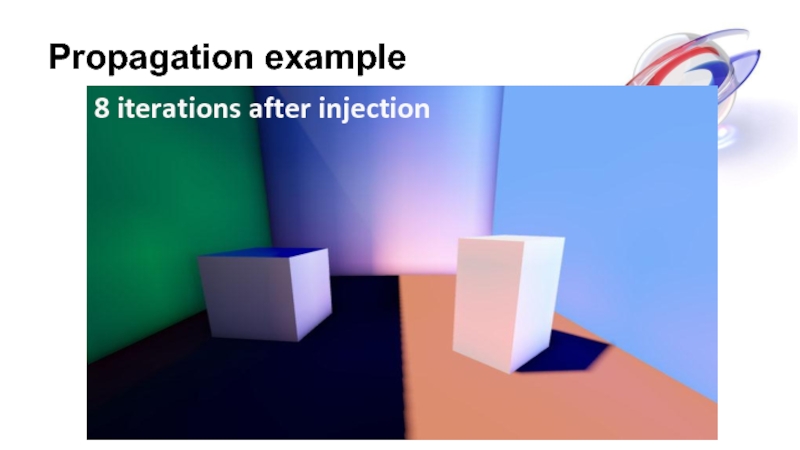
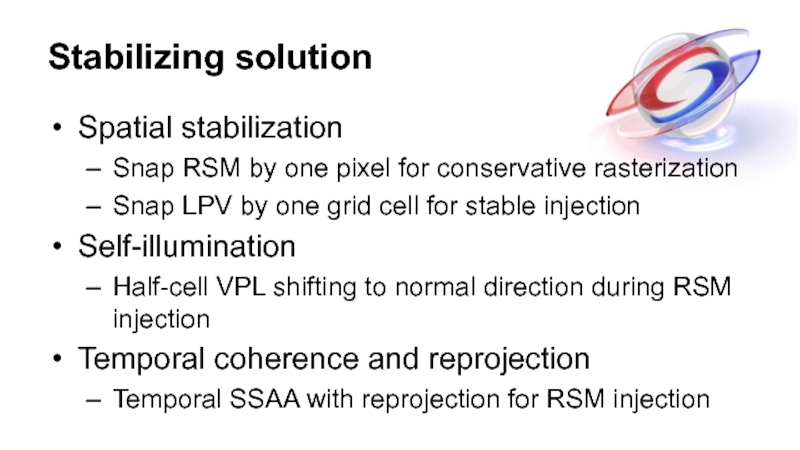
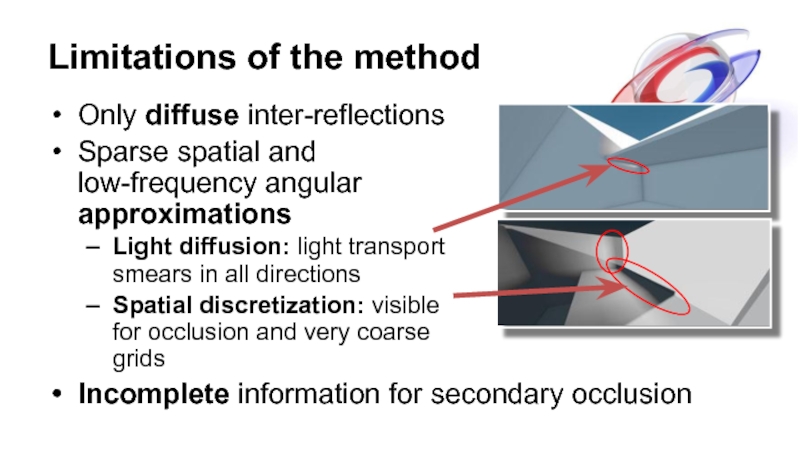
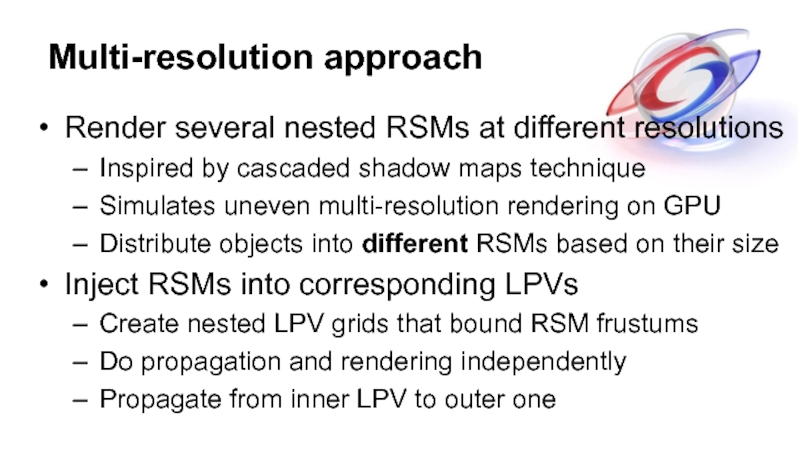
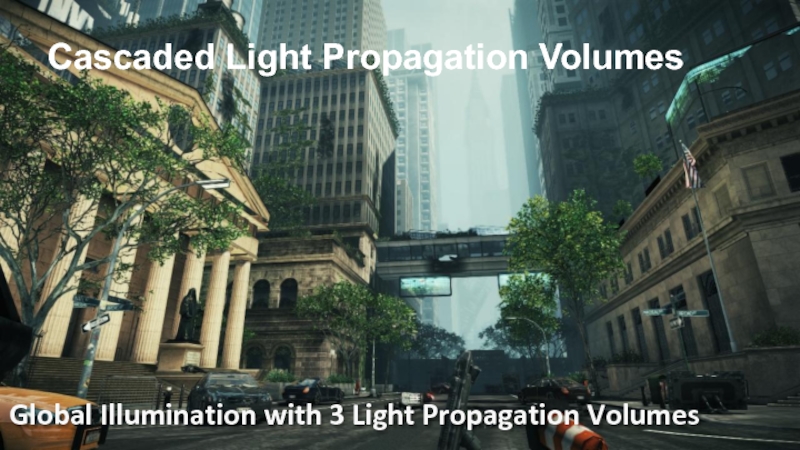
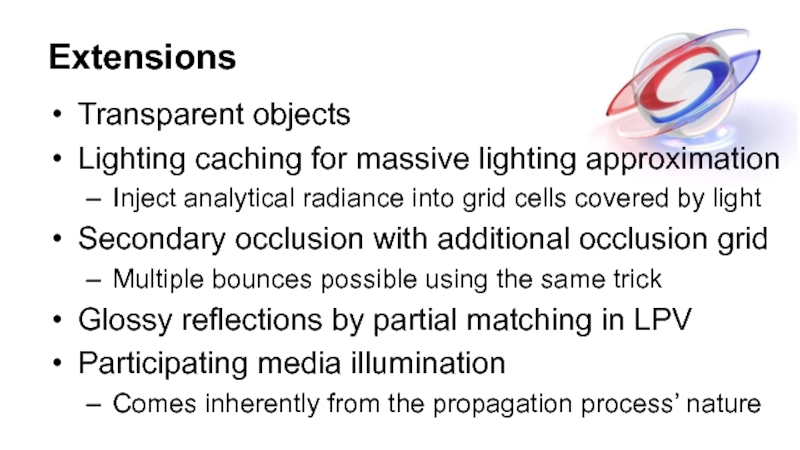

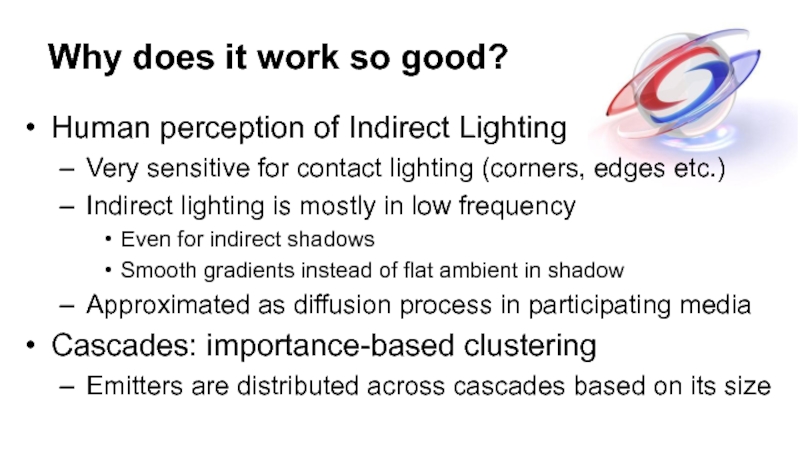
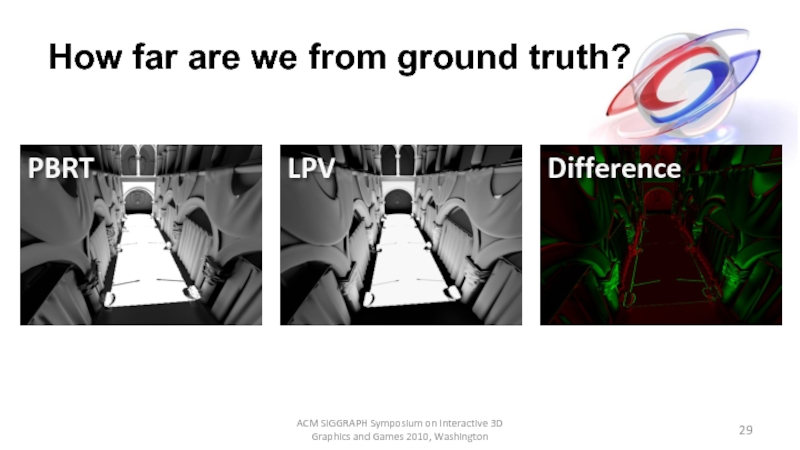
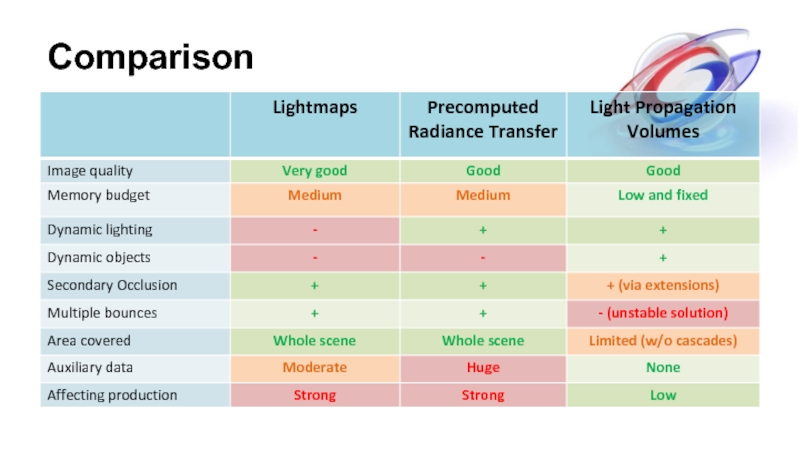
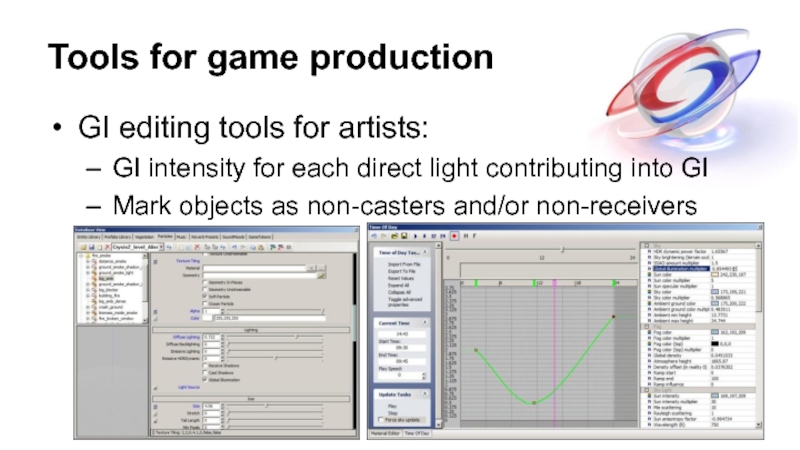

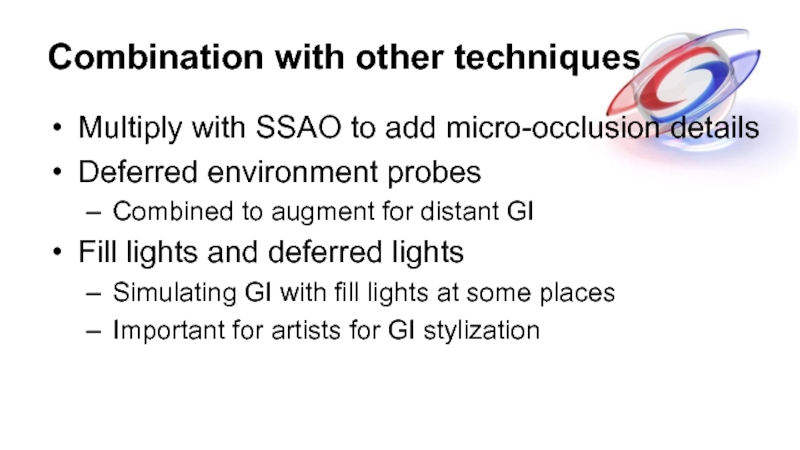
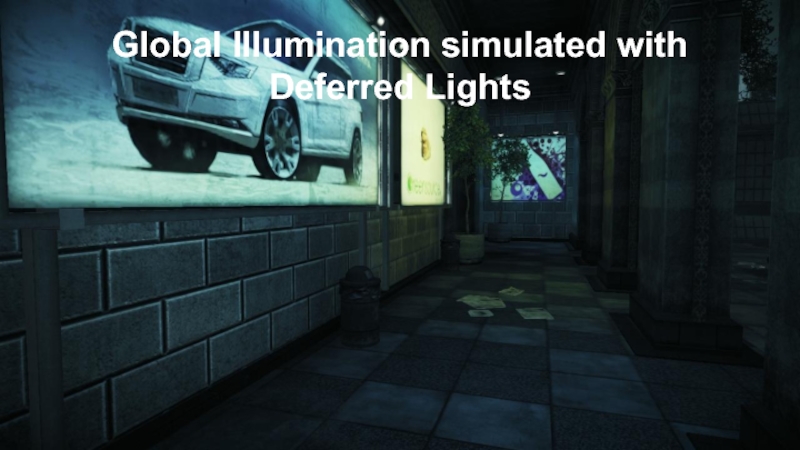
![Console optimizationsFor both consolesStore everything in signed QUVW8 format, [-1;1] with scaling factorUse h/w 3D](/img/tmb/1/29259/41ebfb6849f9f2a1e3bdf953d91da8e7-800x.jpg)
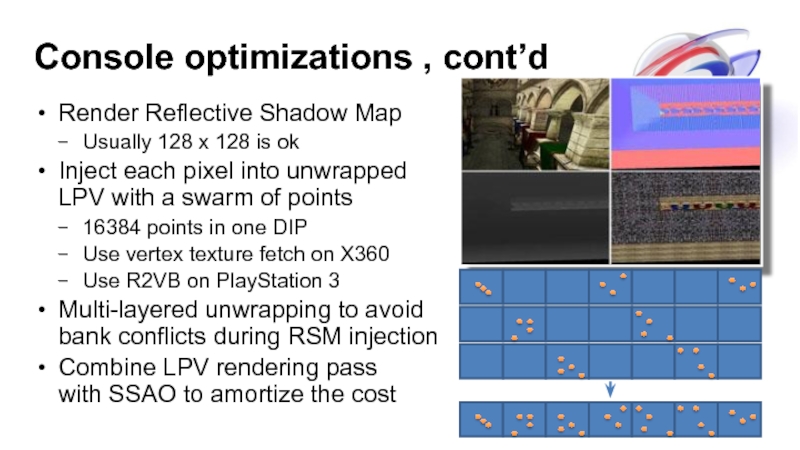
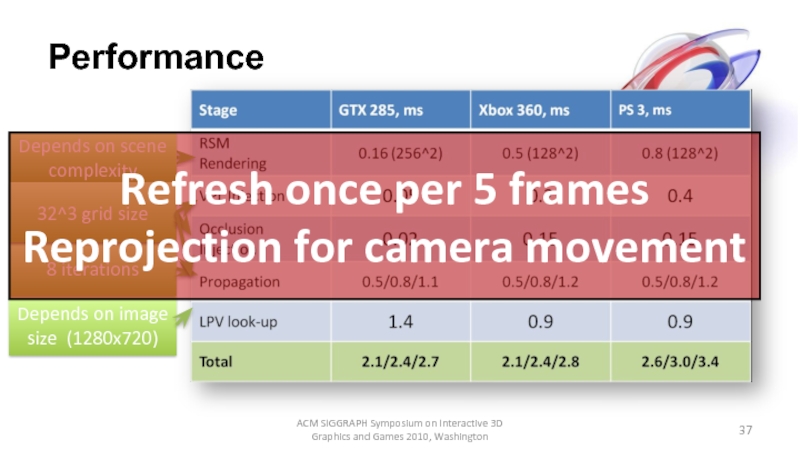
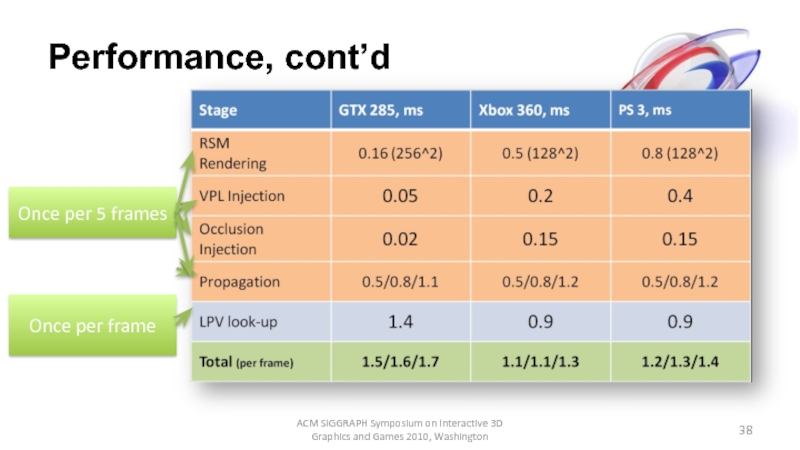


![References[Bunnel05] Bunnel, M. 2005 “Dynamic ambient occlusion and indirect lighting”, GPU Gems 2[Christensen07] Christensen, P.](/img/tmb/1/29259/f36677cd9866ade54027a3c87fe43620-800x.jpg)
